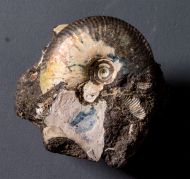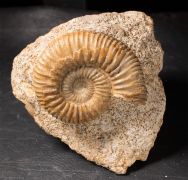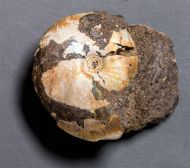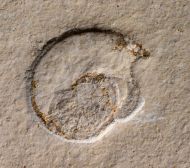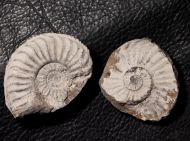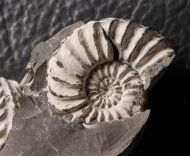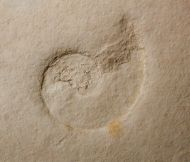Fossils for sale
Welcome back!
Ammonites

Ammonites for sale
Ammonites are a subgroup of cephalopods (Cephalopoda) that went extinct about 65 million years ago. They were very diverse and had over 1500 genera and up to 40,000 species. Their shells are often preserved as fossils and serve as important witnesses of Earth's history.
An example of an index fossil is Parapuzosia seppenradensis, the largest known ammonite species. It had a shell diameter of about 1.80 meters and lived in the Upper Cretaceous. Another example is Ceratites nodosus, an index ammonite in the Triassic. It had a knotty shell and could survive in salty and shallow waters.
Ammonites are therefore a fascinating group of extinct cephalopods that can reveal a lot about Earth's history. They testify to their systematic position, their role as index fossils and their impressive diversity.
Ammonites are a fascinating group of extinct cephalopods
Ammonite Systematics
Ammonites belong to the molluscs (Mollusca), a large group of animals with a soft body and usually a shell. Within the molluscs, they are part of the cephalopods (Cephalopoda), which are characterized by a head with arms and tentacles. The cephalopods also include the modern squids, octopuses and nautiluses. The ammonites are divided into three subgroups: Palaeoammonoidea, Mesoammonoidea and Neoammonoidea. These differ mainly in the shape and structure of their shells.Index fossils
Ammonites are very important for paleontology, because they can be used as index fossils. This means that they can be assigned to specific time periods based on their shell shape and structure. Ammonites first appeared in the Lower Devonian about 400 million years ago and died out at the end of the Cretaceous period about 65 million years ago. In this long time, they changed quickly and adapted to different habitats. They were also geographically widespread and occur on all continents. With the help of ammonites, different rock layers can be dated and correlated.An example of an index fossil is Parapuzosia seppenradensis, the largest known ammonite species. It had a shell diameter of about 1.80 meters and lived in the Upper Cretaceous. Another example is Ceratites nodosus, an index ammonite in the Triassic. It had a knotty shell and could survive in salty and shallow waters.
Diversity
The diversity of ammonites is impressive. They varied in size, shape and structure of their shells. Most ammonites had a planispiral shell, that is, a spiral rolled up in one plane. But there were also other shell shapes, such as evolute, involute, heteromorphic or uncoiled. The size of the shell was usually between 1 and 30 cm, but there were also exceptions like Parapuzosia seppenradensis. The shell structure was also very variable. An important part of the shell was the phragmocone, the chambered part that was filled with gas. The phragmocone was divided into smaller chambers by septa (septal walls). The septa became more complex over the course of evolution and often had folded or lobed edges. The shape and number of septa influenced the stability and swimming behavior of the ammonites.Ammonites are therefore a fascinating group of extinct cephalopods that can reveal a lot about Earth's history. They testify to their systematic position, their role as index fossils and their impressive diversity.
Ammonites are a fascinating group of extinct cephalopods
More sub categories:
Here is a beautiful ammonite of the species Craspedites subditus from the Volga Stage of the Yaroslavl region.
Shipping time: 3-4 Days
39,95 EUR
7 % VAT incl.
This is an ammonite of the species Garantiana wetzeli as a beautiful matrix piece. The ammonite measures about 58 mm.
Shipping time: 3-4 Days
39,95 EUR
7 % VAT incl.
Here is a beautiful and realtive rare ammonite of the species Garniericeras catenulatum from the Volga Stage of the Yaroslavl region.
Shipping time: 3-4 Days
46,95 EUR
7 % VAT incl.
Nice and large Ammonit nice preservation also in the inner windings.
Shipping time: 3-4 Days
29,95 EUR
7 % VAT incl.
This Solnhofen ammonite belongs to the species Lingulaticeras solenoides.
Shipping time: 3-4 Days
14,95 EUR
7 % VAT incl.
This is good evidence of a relatively rare Amaltheus margaritatus from Buttenheim. The fossil comes with both positive and negative side.
Shipping time: 3-4 Days
12,95 EUR
7 % VAT incl.
Here is a wonderfull fossil ammonite of the species Pseudokatosira undulate from the lower Jurassic of Buttenheim, Germany. The fossil is well placed on the nice piece of matrix.
Shipping time: 3-4 Days
16,95 EUR
7 % VAT incl.
This "Solnhofen Ammonite" belongs to the species Neochetoceras sterapsis .
Shipping time: 3-4 Days
14,95 EUR
7 % VAT incl.




